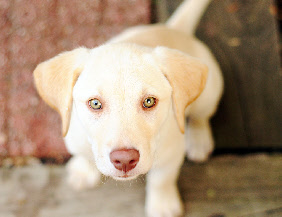© 2008 Hampstead Animal Hospital

 Proper place to relieve itself.
Proper place to relieve itself.
Develop bladder controllability to conscientiously
"hold it" for a gradually increasing time period.
An idea of where it is NOT ok to
relieve itself.
#1-
Make sure the puppy is relieving itself in the designated area each time it voids. The puppy has absolutely no responsibility in this…it’s all up to YOU as the handler to predict and take action, and get the puppy out there when it’s time to go. How is this possible?
Predict when the pup needs to go. Very young puppies of 7 weeks of age will need
to go during the day about once every 45 minutes or more. Plan to get the puppy outside
as soon as possible after he eats, heavily drinks, wakes up, or has an active playtime.
This means that for the first week or so, you must plan on being able to give near-
Housetraining (For Puppies & Dogs)
Lisa Giroux, Corner Brook Newfoundland, 686-
A New PuppyStarting off Right!
Note: If you are adopting an older dog into your home,
do not assume that if he was housetrained in
another home he will automatically be
clean in YOUR home. In order to prevent unintentional learning,
please follow the
modified "older dog" housetraining tips at the end of this article.
There are a few
basic things that a puppy needs to learn in order to become reliably housetrained.
Dogs
have no idea that humans consider pee and poo in the house reprehensible! THERE
IS NO NATURAL
INSTINCT THAT TELLS THE DOG NOT TO GO IN YOUR HOME. Here are the three
basic things you
need to teach your new puppy:

Secondly, you need to try to totally prevent accidents. If your puppy goes to the bathroom in your home, he has learned that your house is an OK place to void. Each time he repeats this experience, it is cementing in his little brain that the house is the place to do it. You must prevent these accidents from happening by paying sharp attention to the puppy.
Use of confinement is a very helpful tool during the housetraining of a puppy. Because
even very young dogs will avoid elimination in small areas, keeping the puppy confined
to a small space will allow you to avoid many accidents. You can do this with a crate,
by leashing the puppy to you, or by making a small partition near where you will
be, daytime and night. The confinement space must be small enough that the puppy
cannot go to one end, void, and go to the other end and lie down. If you have an
adult-
Confinement is not, by any means, a cruel thing to teach a dog. Dogs who are taught
to relax in a confined area will regard that area as their den, a place to go where
they can rest undisturbed. Dogs that are crate-
The puppy must never be out of your sight while unconfined. This means NEVER. If you cannot have your eyes directly on your puppy, even if he has just eliminated, confine him.
#2—Developing Bladder Control
7-
Confinement, in the beginning, can be a great tool for developing bladder control. Puppies can rest in a crate for up to about 1 ½ hours during the day, longer at night, before needing to be let out. This will actually increase the volume their bladders can handle, and will aid in housetraining. Puppies that are active in their crates (heavy chewing, or possibly just restless behaviour or vocalizing) need to be let out more often.
Puppies that are less than 7 weeks of age may need to be let out during the night.
You can reduce the chances they will need to go at night by feeding them for the
last time at around 6:00 p.m. and picking up water at 6:30. Note: Allowing totally
free access to food will probably lengthen the training period and may cause problems
later in life with feeding habits. Consult your vet on your puppies’ food scheduling
needs. Get them out for the last time at around 10:30-
After a few days, most pups begin sleeping through the night. After about the age
of 8-
#3—Where is it NOT ok to go?
At some point, no matter how diligent you are, a puppy will have an accident on the floor. If you have been adequately supervising the puppy, you should see the accident happening. AS IT IS HAPPENING, make a sharp AHH AHH sound, grab puppy up and take him outdoors. As soon as you arrive outdoors, say “good puppy” sweetly. You must change your demeanor right away no matter how frustrated you might be. You want the puppy to learn, “indoors Human doesn’t like it, outdoors Human thinks I’m a GOOD PUPPY.” If you continue to tell the dog AHH AHH or remain in a “bad mood,” you will be teaching the puppy that he needs to be very far away from you to go to the bathroom. This can lead to the puppy avoiding eliminating in your presence outside, then coming indoors and not being able to hold it any longer and having accidents. So, short form…puppy pees, you say AHH AHH and grab it and go outdoors, then you turn into Sweet Loving Praiseful Human the second you get out the door.
Housetraining a puppy successfully is largely the result of doing a LOT of good observation
work in the first few weeks. It’s not difficult but it does take a lot of your time
and attention. Keep in mind that the “hard stuff” is over within a very short time,
and the after-


- Keep your doors shut in the house, or install baby gates so that you can confine the puppy into the same room with you. Remember, out of sight means ACCIDENTS.
- Even after the puppy seems pretty much housetrained, keep doors to other rooms in
the house shut. Puppies learn their housetraining room by room. Their instinct tells
them, “don’t pee where I live,” and you have to teach them that they do, indeed,
live in the whole house and not just the kitchen or living room. Spend time in less-
popular rooms of the house with him…sit down and read a book for a while or something, so that he will understand “aha, we live HERE too” and will understand that he’s not to go to the bathroom there. Accidents are common in back bedrooms and formal sitting rooms…he’s not trying to “hide it” or “get revenge,” he just doesn’t know those rooms are included yet. As far as he’s concerned, they are fair game because “we don’t live there.” - Reward lavishly for any behaviour such as going to the door or otherwise indicating
that he needs to go out, but don’t expect this from your puppy. Some dogs do it,
some don’t. Some dogs will just hold it until you happen to let them out, some will
be more pro-
active. It is NEVER the puppies’ responsibility to tell you he has to go for the first few months of his life. It is always up to you. Some dogs can be trained to ring a hanging bell to ask for the door…great fun to teach and a very useful skill. - As the puppy gets older, you may think that housetraining is “done.” Usually at around 12 weeks, many puppies go through a period of time where it seems that they have tons of accidents and are “backsliding” in what they have learned. This is usually because we have developed faith in them that they are “done” and we slack off on observation. Drop off your constant observation gradually, not suddenly. Best bet? Keep the puppy close to you as much as possible. That’s what all dogs want anyway!
- If you are visiting someone with your dog, never assume that he will know not to
go in their home. Keep him close by and keep your eyes peeled. After he has voided
outside a couple of times you can usually relax a bit about it, but not before. Many
people have been highly embarrassed by their “totally housetrained” dog doing the
doo-
doo on someone else’s rug.
Other Tips

Things NOT to do when housetraining
- Don’t ever rub your puppy’s face into his urine or feces. He will not connect his
previous actions with what you are doing. What he will learn from this all-
too- commonly used exercise is that his master sometimes grabs him and rubs his face in poo and should therefore be avoided and looked at with distrust, especially if there happens to be poo in the room. IT WILL NOT TEACH HIM ANYTHING CONSTRUCTIVE AND MAY SEVERELY DAMAGE YOUR RELATIONSHIP. - If you find an accident that you did not witness happening, clean it up and remind yourself to watch the puppy more closely, and forget about it. Don’t bring the dog to the site and try to get him to understand you’re not happy. Dogs only learn to associate things when they are very close together…would you tell the dog “sit,” and then wait 10 minutes to give him a treat? He would not learn the sit command from that kind of training, and he will not learn anything constructive from being brought to the site of an accident that happened minutes or even hours ago.
- Don’t expect a young puppy to be able to hold it for unreasonable lengths of time.
A 7 week old puppy can be expected to hold it for a maximum of 1 ½ -
2 hours when confined during the day, and 4- No dog should be expected to stay in a crate for the length of a normal working day, even as an adult. Please contact a trainer to get solutions for dogs that need to be alone for long periods of time.5 hours at a stretch at night. After 9 weeks or so, the time can be gradually increased to up to about 4 hours in a crate during daytime hours, and all night (8- 10 hours). If you do not allow opportunities for the dog to relieve itself, the dog will eventually have an accident in the crate, which can cause a disregard for cleanliness.
Things Not To Do When Housetraining

The key to making a great start with a new adult dog is that you have a plan of action
prior to bringing the dog home. With most dogs, the process takes only a day or
two. If the dog is previously totally un-
- When you first bring him home, keep him on leash with you in the house until he has relieved outdoors. Stay outside with him and praise lavishly, give a treat as he’s going.
- Immediately after he has relieved himself outdoors, bring him in and walk through the whole house with him. Don’t let him roam too far from you. If it’s a male dog, WATCH OUT! If you see him sniffing the sides of a sofa or the corner of a wall or doorjamb, interrupt this with a sharp AHH AHH or a couple of hand claps, and get him outdoors. If your dog is male and attempts to hike his leg to mark, you must keep a VERY sharp eye on him for the first few days or he will do it on every vertical surface. What’s great is that if you prevent these instances from occurring right from the start, they usually “get it” right away and don’t attempt it anymore. A couple of satisfying markings in the house, though, will keep him doing it for ages. Be attentive!
- For the first few days, don’t allow him free access to the whole house. Keep him where you can see him, get him outdoors often and praise for doing it out there.
- If you catch him in the act of having an accident, a sharp AHH AHH and immediately taking him outdoors to finish, followed by praise for doing so, should help him understand. Remember, if you didn’t see it happening, forget about it. No good punishing after the fact. Watch him more closely.
- Keep him confined when you can’t watch him until your “gut instinct” tells you it’s absolutely safe to let him have more freedom. Give him this freedom gradually and watch carefully to make sure he’s not going to a back bedroom to do his thing.
IMPORTANT NOTES ON HEALTH : If you are not getting anywhere with housetraining, your dog or puppy seems to be urinating or defecating to an unusual degree, or your previously reliably trained dog is having unexplainable accidents, please consult your veterinarian. Dogs and puppies can suffer from various common illnesses that affect their ability to control urination and defecation.
“Older Dog” Housetraining
© Fiona Johnson Photography






